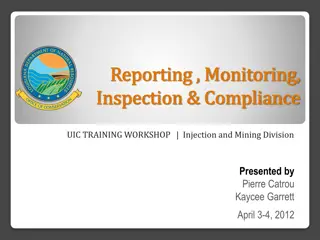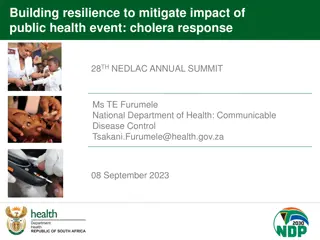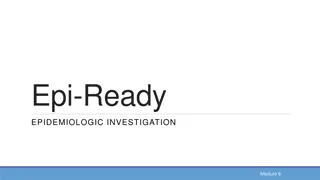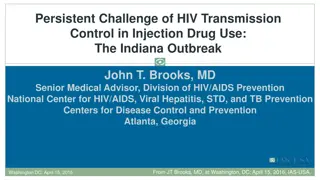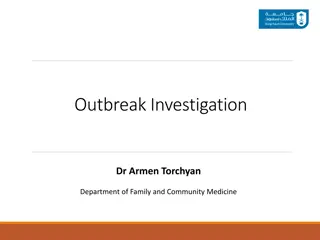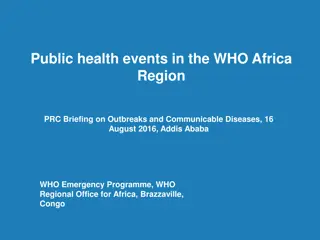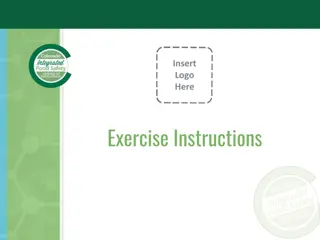Safe Injection Practices and Outbreaks: Consequences, Best Practices, and Prevention
Discuss the consequences of unsafe injection practices, outbreaks in outpatient settings, and the importance of safe injection best practices. Learn about the One and Only Campaign, NC Viral Hepatitis Outbreaks, and the Big Five factors contributing to outbreaks. Understand the risks associated with syringe reuse, improper use of vials, lack of aseptic techniques, unsafe diabetes care, and drug diversion.
Download Presentation

Please find below an Image/Link to download the presentation.
The content on the website is provided AS IS for your information and personal use only. It may not be sold, licensed, or shared on other websites without obtaining consent from the author.If you encounter any issues during the download, it is possible that the publisher has removed the file from their server.
You are allowed to download the files provided on this website for personal or commercial use, subject to the condition that they are used lawfully. All files are the property of their respective owners.
The content on the website is provided AS IS for your information and personal use only. It may not be sold, licensed, or shared on other websites without obtaining consent from the author.
E N D
Presentation Transcript
D Safe Injection Practices Module D
D Safe Injection Practices Objectives Discuss the consequences of unsafe injection practices Describe outbreaks Discuss safe injection best practices Describe One and Only Campaign
D Safe Injection Practices Unsafe Injection Practices
D Safe Injection Practices Outbreaks in Outpatient Settings Outbreaks and patient notifications have occurred in a variety of settings including: Primary care clinics Pediatric offices Cosmetic surgery centers Pain remediation clinics Infection Prevention breaches included but may not have been limited to the following: Reuse of syringes Failure to properly reprocess reusable equipment Lack of aseptic technique while preparing medications Cancer (oncology) clinics Pain Management clinic HBC and HCV transmission resulted in over 2,000 patient notifications Reuse of single dose vials Drug diversion by a healthcare provider
D Safe Injection Practices NC Viral Hepatitis Outbreaks Healthcare Setting Breach in Infection Prevention Assisted blood glucose monitoring (ABGM) Long Term Care Exposed - 504 Infections - 31 Deaths - 6 Syringe reuse and contaminating multi-dose vials Cardiology Clinic Exposed - 1200 Infections - 5 Reported To CDC 2008-2017
D Safe Injection Practices Knowledge Check Which of the following statements is correct? CDC reports that most outbreaks occur in the hospital A. Outbreaks of HIV are the most common type of outbreak B. CDC reports that most outbreaks occur in non-hospital settings and are associated with breaches in infection prevention, including unsafe injection practices C.
D Safe Injection Practices Why Do Outbreaks Happen?
D Safe Injection Practices The Big Five THE BIG 5 1. Syringe re-use, directly or indirectly 2. Inappropriate use of single dose or single use vials 3. Failure to use aseptic technique (contamination of injection equipment) 4. Unsafe diabetes care/ assisted blood glucose monitoring (ABGM) 5. Drug diversion
D Safe Injection Practices Syringe Re-use Most common cause of outbreaks in the outpatient setting is inappropriate use of syringes: Direct reuse: Using the same syringe to administer medication to more than one patient, even if the needle is changed or the injection was administered through an intervening length of tubing Indirect reuse or double dipping : Accessing a medication vial or bag with a syringe that has already been used to administer medication to a patient, then reusing the contents from the vial or bag for another patient
D Safe Injection Practices Video Clip: Start the video by clicking on the image below. Syringe Re-use
D Safe Injection Practices Endoscopy Center, Nevada (2008) 9 clinic-associated hepatitis C virus cases 106 possible clinic-associated cases 63,000 potential exposures $16 21 million total cost
D Safe Injection Practices Dangerous Misperceptions 1.Changing the needle makes a syringe safe for reuse. 2.Syringes can be reused as long as an injection is administered through an intervening length of IV tubing. 3.If you don't see blood in the IV tubing or syringe, it means that those supplies are safe for reuse. Once they are used, both the needle and syringe are contaminated and must be discarded!
D Safe Injection Practices Inappropriate Use of Single-dose/Single-use Vials Vials labeled as single use: NO PRESERVATIVE Can be accessed one time only and for one patient only and remaining contents must be discarded CDC is aware of at least 19 outbreaks involving single dose vial use All occurred in outpatient setting with almost half in pain remediation clinics
D Safe Injection Practices Single Dose Vials: CDC Position Statement, 2012 Vials labeled by the manufacturer as single dose or single use should only be used for a single patient Ongoing outbreaks provide ample evidence that inappropriate use of single-dose/single-use vials causes patient harm. Leftover parenteral medications should never be pooled for later administration In times of critical need, contents from unopened single dose vials can be repackaged for multiple patients in accordance with standards in United States Pharmacopeia General Chapter 797 www.cdc.gov/injectionsafety/CDCposition-SingleUseVial.html
D Safe Injection Practices When Failure To Use Aseptic Technique Happens! Two women diagnosed with HBV infection, receiving chemotherapy at the same physician practice Multidisciplinary team investigation Office closed; physician license suspended 2,700 patients notified 29 outbreak-associated cases of HBV
D Safe Injection Practices New Jersey Oncology Office IV bags with stoppers removed IV bags used as sources of fluid to flush catheters for multiple patients
D Safe Injection Practices New Jersey Oncology Office Blood drawing equipment in area of medication preparation Medication prepared in hood in patient treatment area Uncapped syringes for flushing IVs unwrapped and prefilled in advance Medication prepared in advance Failure to use aseptic technique
D Safe Injection Practices New Jersey Oncology Office Reused Vacutainer holders in contact with gauze Blood contamination
D Safe Injection Practices Knowledge Check Which of the following statements is false? A. Syringes can be used on more than one patient if the needle is changed. B. Single dose vials can be used more than one time if it has not been contaminated C. Blood glucose meters do not have contact with patients and do not need to be cleaned D. If there is no visible blood the syringe is safe to reuse. All the above E.
D Safe Injection Practices Unsafe Diabetes Care Use of fingerstick devices or insulin pens on multiple Fingerstick Devices/Insulin Pens persons Sharing of blood glucose meters without cleaning and disinfection between Failure to perform hand hygiene or change gloves between procedures Hand Hygiene Failure Blood Glucose Meters uses Patel et al. ICHE 2009; 30:209-14,Thompson et al. JAGS 2010, MMWR 2005; 54:220-3
D Safe Injection Practices Drug Diversion 5. Drug diversion Substandard care delivered by an impaired provider Denial of essential pain medication or therapy Risks of infection Bloodborne pathogen Bacterial contaminants
D Safe Injection Practices Year 2018 12 2018 6 2015 7 2014 5 2012 45 Cases Outbreak HCV infections associated with an emergency department nurse Sphingomonas paucimobilis bacteremia associated with a nurse at a cancer center HCV infections associated with a nurse at a hospital Serratia marcescens bacteremia associated with a nurse in a post-anesthesia care unit at a hospital HCV infections associated with a radiology technician at hospitals in NH, Kansas and Maryland Gram negative bacteremia associated with a nurse at a Minnesota hospital 2011 25 2009 18 2008 5 2006 9 2004 16 1999 26 HCV infection associated with a surgical technician at a Colorado hospital HCV infections associated with a radiology technician at a Florida hospital Achromobacter xylosoxidans bacteremia associated with a nurse at an Illinois hospital HCV infections associated with a certified registered nurse anesthetist at a Texas hospital Serratia marcescens bacteremia associated with a respiratory therapist at a Pennsylvania hospital HCV infections associated with a surgical technician at a Texas ambulatory surgical center 1992 45 1985 3 Pseudomonas pickettii bacteremia associated with a pharmacy technician at a Wisconsin hospital
D Safe Injection Practices Safe Injections: Best Practices Misuse of single-dose/single-use vials Never administer medications from the same syringe to multiple patients Do not reuse a syringe to enter a medication vial or solution Limit the use of multi-dose vials and dedicate them to a single patient whenever possible Syringe reuse (direct and indirect) Do not administer medications from a single dose vial or IV solution bag to more than one patient, more than one time
D Safe Injection Practices Safe Injections: Best Practices Failure to use aseptic technique Use aseptic technique when preparing or administering medications Keep contaminated items and surfaces away from the preparation area. Designate a clean medication preparation area that is not adjacent to contaminated items Perform hand hygiene before handling medications. Unsafe diabetes care Use insulin pens and lancing devices for only one patient Dedicate glucometers to a single patient. If they MUST be shared, clean and disinfect after each use
D Safe Injection Practices Safe Injections: Best Practices Drug Diversion Institue drug diversion monitoring systems and security measure to assist in averting and/or identifying diversion activity.
D Safe Injection Practices Most Outbreaks are Never Detected Under-reporting of cases Asymptomatic infection Under-recognition of healthcare as risk Long incubation period; difficult to identify single healthcare exposure Barriers to investigation, resource constraints
D Safe Injection Practices Survey of Physician and nurse Practices around injection safety 370 Physicians 320 Nurses Eight States Included NC, NY, NJ, Nevada, Colorado, Tennessee, Wisconsin, Montana Types of healthcare settings: Acute care, long term care, outpatient settings https://www.sciencedirect.com/science/article/pii/S0196655317306806?via%3Dihub
D Safe Injection Practices Survey findings Topic Physician Response Is Acceptable Practice Nurse Response Reuse of syringe for > one patient 12.4% 3.4% Reentering a vial with a used needle/syringe 12.7% 6.7% Using SDVs for multiple patients 34% 16.9% Using source bags as diluent for multiple patients 28.9% 13.1%
D Safe Injection Practices Knowledge Check True or False? Because there have been so many outbreaks, ALL healthcare providers do the right thing every time with safe injection practices. True False
D Safe Injection Practices Best Practice Designate someone to provide ongoing oversight Develop written infection control policies Provide training Conduct quality assurance assessments Prevention Knowledge Speak Up!
D Safe Injection Practices One and Only Campaign
D Safe Injection Practices Campaign Resources Print Materials Audio & Visual Social Media Toolkits
D Safe Injection Practices


